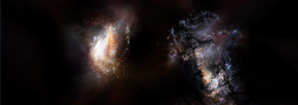Most Massive Galaxy in the Early Universe Shown as it Assembles

A group of astronomers led by Steward Observatory's Dr. Daniel Marrone has found a titanic clash of galaxies in the infant universe (Steward collaborators include Marrone, former Steward grad student Justin Spilker (PhD 2017), and current grad students Katrina Litke and Mengtao Tang). The galaxies, observed when the universe was only 780 million years old, were originally discovered using the NSF's South Pole Telescope, with exquisite high-resolution observations made later with the ALMA array of radio telescopes in the Atacama Desert of Chile. The observations reveal the presence of two galaxies, separated by just 25,000 light years, in the process of merging to form one ultra-massive galaxy. The larger of the two galaxies experiences a phenomenon called gravitational lensing, which distorts and magnifies the light from the massive galaxy around a foreground galaxy aligned almost perfectly along our sightline from earth. After using sophisticated computer models to account for this lensing effect, the researchers were able to reconstruct what the galaxy would look like if the foreground galaxy wasn't there. The observations show that the two galaxies were forming stars thousands of times faster than our own Milky Way does today, and contain about 300 billion times the mass of our own sun in gas, which fuels the formation of new stars. Together, the pair make up the most massive known system at such an early point in the history of the universe, and is about as massive as any galaxy should be at such early times given our understanding of how galaxies form. (The image on this page is an artist's conception.)
You can read the UA News article HERE.

For Public
Public events include our Monday Night Lecture Series, world-reknowned Astronomy Camp and Mt Lemmon Sky Center.

For Students
A good place to start if you want to become an undergrad major or grad student, or need to find our schedule of classes.

For Scientists
Find telescopes and instruments, telescope time applications, staff and mountain contacts, and faculty and staff scientific interests.




